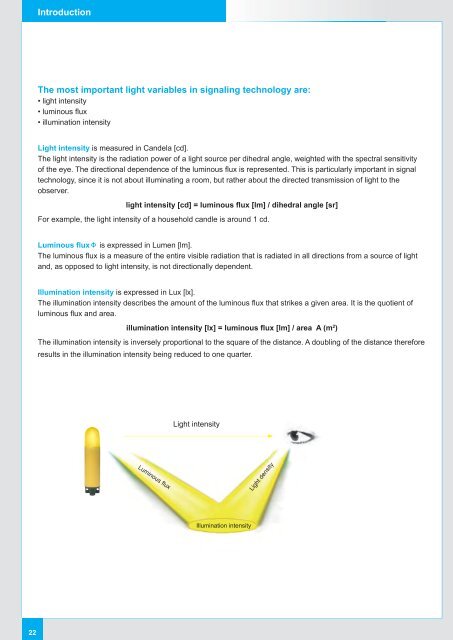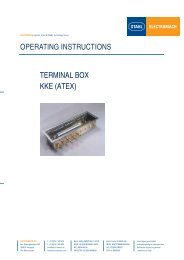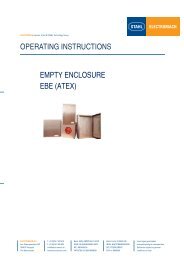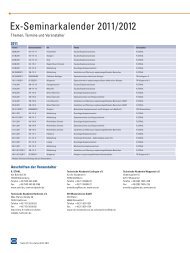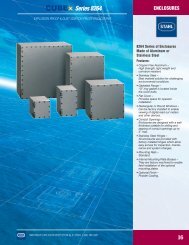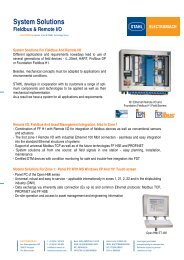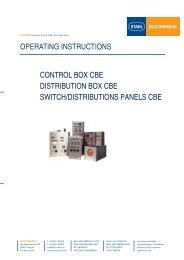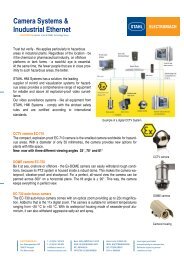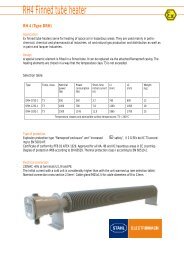- Page 1 and 2: The complete Spectrum of Signaling
- Page 3 and 4: ELECTRO-TECHNOLOGY FOR INDUSTRY Saf
- Page 5 and 6: ELECTRO-TECHNOLOGY FOR INDUSTRY 5 g
- Page 7 and 8: ELECTRO-TECHNOLOGY FOR INDUSTRY Sig
- Page 9 and 10: ELECTRO-TECHNOLOGY FOR INDUSTRY New
- Page 11 and 12: ELECTRO-TECHNOLOGY FOR INDUSTRY New
- Page 13 and 14: ELECTRO-TECHNOLOGY FOR INDUSTRY New
- Page 15 and 16: Approvals and test symbols ELECTRO-
- Page 17 and 18: Life cycle - Maintenance-free ELECT
- Page 19 and 20: ELECTRO-TECHNOLOGY FOR INDUSTRY Pfa
- Page 21: ELECTRO-TECHNOLOGY FOR INDUSTRY Tec
- Page 25 and 26: ELECTRO-TECHNOLOGY FOR INDUSTRY Tec
- Page 27 and 28: ELECTRO-TECHNOLOGY FOR INDUSTRY Tec
- Page 29 and 30: ELECTRO-TECHNOLOGY FOR INDUSTRY Tec
- Page 31 and 32: Pfannenberg on the Internet ELECTRO
- Page 33 and 34: ELECTRO-TECHNOLOGY FOR INDUSTRY A f
- Page 35 and 36: ELECTRO-TECHNOLOGY FOR INDUSTRY Typ
- Page 37 and 38: ELECTRO-TECHNOLOGY FOR INDUSTRY Typ
- Page 39 and 40: ELECTRO-TECHNOLOGY FOR INDUSTRY Dim
- Page 41 and 42: ELECTRO-TECHNOLOGY FOR INDUSTRY Dim
- Page 43 and 44: ELECTRO-TECHNOLOGY FOR INDUSTRY Dim
- Page 45 and 46: ELECTRO-TECHNOLOGY FOR INDUSTRY Dim
- Page 47 and 48: ELECTRO-TECHNOLOGY FOR INDUSTRY Dim
- Page 49 and 50: ELECTRO-TECHNOLOGY FOR INDUSTRY Dim
- Page 51 and 52: ELECTRO-TECHNOLOGY FOR INDUSTRY Dim
- Page 53 and 54: ELECTRO-TECHNOLOGY FOR INDUSTRY Dim
- Page 55 and 56: ELECTRO-TECHNOLOGY FOR INDUSTRY Ope
- Page 57 and 58: ELECTRO-TECHNOLOGY FOR INDUSTRY Dim
- Page 59 and 60: ELECTRO-TECHNOLOGY FOR INDUSTRY Dim
- Page 61 and 62: ELECTRO-TECHNOLOGY FOR INDUSTRY Dim
- Page 63 and 64: ELECTRO-TECHNOLOGY FOR INDUSTRY Dim
- Page 65 and 66: ELECTRO-TECHNOLOGY FOR INDUSTRY Dim
- Page 67 and 68: ELECTRO-TECHNOLOGY FOR INDUSTRY Dim
- Page 69 and 70: ELECTRO-TECHNOLOGY FOR INDUSTRY Dim
- Page 71 and 72: ELECTRO-TECHNOLOGY FOR INDUSTRY Dim
- Page 73 and 74:
ELECTRO-TECHNOLOGY FOR INDUSTRY Dim
- Page 75 and 76:
ELECTRO-TECHNOLOGY FOR INDUSTRY Dim
- Page 77 and 78:
ELECTRO-TECHNOLOGY FOR INDUSTRY Dim
- Page 79 and 80:
ELECTRO-TECHNOLOGY FOR INDUSTRY Dim
- Page 81 and 82:
ELECTRO-TECHNOLOGY FOR INDUSTRY Dim
- Page 83 and 84:
ELECTRO-TECHNOLOGY FOR INDUSTRY Dim
- Page 85 and 86:
ELECTRO-TECHNOLOGY FOR INDUSTRY Dim
- Page 87 and 88:
ELECTRO-TECHNOLOGY FOR INDUSTRY Dim
- Page 89 and 90:
ELECTRO-TECHNOLOGY FOR INDUSTRY Dim
- Page 91 and 92:
ELECTRO-TECHNOLOGY FOR INDUSTRY Dim
- Page 93 and 94:
ELECTRO-TECHNOLOGY FOR INDUSTRY Dim
- Page 95 and 96:
ELECTRO-TECHNOLOGY FOR INDUSTRY Dim
- Page 97 and 98:
ELECTRO-TECHNOLOGY FOR INDUSTRY Dim
- Page 99 and 100:
ELECTRO-TECHNOLOGY FOR INDUSTRY Dim
- Page 101 and 102:
ELECTRO-TECHNOLOGY FOR INDUSTRY Dim
- Page 103 and 104:
ELECTRO-TECHNOLOGY FOR INDUSTRY Dim
- Page 105 and 106:
ELECTRO-TECHNOLOGY FOR INDUSTRY Dim
- Page 107 and 108:
ELECTRO-TECHNOLOGY FOR INDUSTRY Dim
- Page 109 and 110:
ELECTRO-TECHNOLOGY FOR INDUSTRY Dim
- Page 111 and 112:
ELECTRO-TECHNOLOGY FOR INDUSTRY Dim
- Page 113 and 114:
ELECTRO-TECHNOLOGY FOR INDUSTRY Dim
- Page 115 and 116:
ELECTRO-TECHNOLOGY FOR INDUSTRY Dim
- Page 117 and 118:
ELECTRO-TECHNOLOGY FOR INDUSTRY Dim
- Page 119 and 120:
ELECTRO-TECHNOLOGY FOR INDUSTRY Pro
- Page 121 and 122:
Wall bracket Wall bracket for mount
- Page 123 and 124:
Connection diagrams ELECTRO-TECHNOL
- Page 125 and 126:
ELECTRO-TECHNOLOGY FOR INDUSTRY PMF
- Page 127 and 128:
ELECTRO-TECHNOLOGY FOR INDUSTRY Sou
- Page 129 and 130:
ELECTRO-TECHNOLOGY FOR INDUSTRY All
- Page 131 and 132:
ELECTRO-TECHNOLOGY FOR INDUSTRY Ala
- Page 133 and 134:
ELECTRO-TECHNOLOGY FOR INDUSTRY Dim
- Page 135 and 136:
ELECTRO-TECHNOLOGY FOR INDUSTRY Dim
- Page 137 and 138:
ELECTRO-TECHNOLOGY FOR INDUSTRY Dim
- Page 139 and 140:
ELECTRO-TECHNOLOGY FOR INDUSTRY Ala
- Page 141 and 142:
ELECTRO-TECHNOLOGY FOR INDUSTRY Sou
- Page 143 and 144:
ELECTRO-TECHNOLOGY FOR INDUSTRY Dim
- Page 145 and 146:
ELECTRO-TECHNOLOGY FOR INDUSTRY Dim
- Page 147 and 148:
Loudspeaker 118 dB (A) / 121 dB (A)
- Page 149 and 150:
ELECTRO-TECHNOLOGY FOR INDUSTRY Dim
- Page 151 and 152:
ELECTRO-TECHNOLOGY FOR INDUSTRY SON
- Page 153 and 154:
ELECTRO-TECHNOLOGY FOR INDUSTRY PA
- Page 155 and 156:
ELECTRO-TECHNOLOGY FOR INDUSTRY See
- Page 157 and 158:
ELECTRO-TECHNOLOGY FOR INDUSTRY Bli
- Page 159 and 160:
ELECTRO-TECHNOLOGY FOR INDUSTRY Ala
- Page 161 and 162:
ELECTRO-TECHNOLOGY FOR INDUSTRY Dim
- Page 163 and 164:
ELECTRO-TECHNOLOGY FOR INDUSTRY Dim
- Page 165 and 166:
ELECTRO-TECHNOLOGY FOR INDUSTRY Dim
- Page 167 and 168:
ELECTRO-TECHNOLOGY FOR INDUSTRY Dim
- Page 169 and 170:
ELECTRO-TECHNOLOGY FOR INDUSTRY Ala
- Page 171 and 172:
ELECTRO-TECHNOLOGY FOR INDUSTRY Ala
- Page 173 and 174:
ELECTRO-TECHNOLOGY FOR INDUSTRY PAB
- Page 175 and 176:
ELECTRO-TECHNOLOGY FOR INDUSTRY Sig
- Page 177 and 178:
ELECTRO-TECHNOLOGY FOR INDUSTRY Dim
- Page 179 and 180:
Signal tower Ø 54 mm BR 50 ELECTRO
- Page 181 and 182:
ELECTRO-TECHNOLOGY FOR INDUSTRY Ord
- Page 183 and 184:
ELECTRO-TECHNOLOGY FOR INDUSTRY Wal
- Page 185 and 186:
ELECTRO-TECHNOLOGY FOR INDUSTRY Ala
- Page 187 and 188:
Safety has no limits ELECTRO-TECHNO
- Page 189 and 190:
ATEX guarantees your safety ELECTRO
- Page 191 and 192:
ATEX guarantees your safety ELECTRO
- Page 193 and 194:
ELECTRO-TECHNOLOGY FOR INDUSTRY Tem
- Page 195 and 196:
ELECTRO-TECHNOLOGY FOR INDUSTRY Typ
- Page 197 and 198:
ELECTRO-TECHNOLOGY FOR INDUSTRY Dim
- Page 199 and 200:
ELECTRO-TECHNOLOGY FOR INDUSTRY Dim
- Page 201 and 202:
ELECTRO-TECHNOLOGY FOR INDUSTRY Dim
- Page 203 and 204:
ELECTRO-TECHNOLOGY FOR INDUSTRY Dim
- Page 205 and 206:
ELECTRO-TECHNOLOGY FOR INDUSTRY Dim
- Page 207 and 208:
ELECTRO-TECHNOLOGY FOR INDUSTRY Dim
- Page 209 and 210:
ELECTRO-TECHNOLOGY FOR INDUSTRY Dim
- Page 211 and 212:
ELECTRO-TECHNOLOGY FOR INDUSTRY Dim
- Page 213 and 214:
ELECTRO-TECHNOLOGY FOR INDUSTRY Dim
- Page 215 and 216:
ELECTRO-TECHNOLOGY FOR INDUSTRY Dim
- Page 217 and 218:
ELECTRO-TECHNOLOGY FOR INDUSTRY Dim
- Page 219 and 220:
ELECTRO-TECHNOLOGY FOR INDUSTRY Dim
- Page 221 and 222:
ELECTRO-TECHNOLOGY FOR INDUSTRY Dim
- Page 223 and 224:
ELECTRO-TECHNOLOGY FOR INDUSTRY Dim
- Page 225 and 226:
ELECTRO-TECHNOLOGY FOR INDUSTRY Dim
- Page 227 and 228:
ELECTRO-TECHNOLOGY FOR INDUSTRY Ala
- Page 229 and 230:
ELECTRO-TECHNOLOGY FOR INDUSTRY Ala
- Page 231 and 232:
ELECTRO-TECHNOLOGY FOR INDUSTRY Dim
- Page 233 and 234:
ELECTRO-TECHNOLOGY FOR INDUSTRY Dim
- Page 235 and 236:
ELECTRO-TECHNOLOGY FOR INDUSTRY Dim
- Page 237 and 238:
ELECTRO-TECHNOLOGY FOR INDUSTRY Dim
- Page 239 and 240:
ELECTRO-TECHNOLOGY FOR INDUSTRY Dim
- Page 241 and 242:
ELECTRO-TECHNOLOGY FOR INDUSTRY Ala
- Page 243 and 244:
ELECTRO-TECHNOLOGY FOR INDUSTRY Tec
- Page 245 and 246:
ELECTRO-TECHNOLOGY FOR INDUSTRY E2x
- Page 247 and 248:
ELECTRO-TECHNOLOGY FOR INDUSTRY BEx
- Page 249 and 250:
ELECTRO-TECHNOLOGY FOR INDUSTRY The
- Page 251 and 252:
ELECTRO-TECHNOLOGY FOR INDUSTRY PSL
- Page 253 and 254:
ELECTRO-TECHNOLOGY FOR INDUSTRY Dim
- Page 255 and 256:
ELECTRO-TECHNOLOGY FOR INDUSTRY Pfa
- Page 257 and 258:
Do you require further information?
- Page 259 and 260:
Support Organisations - Internation


